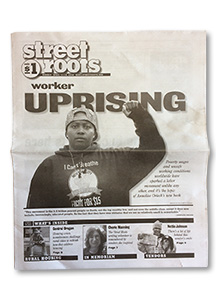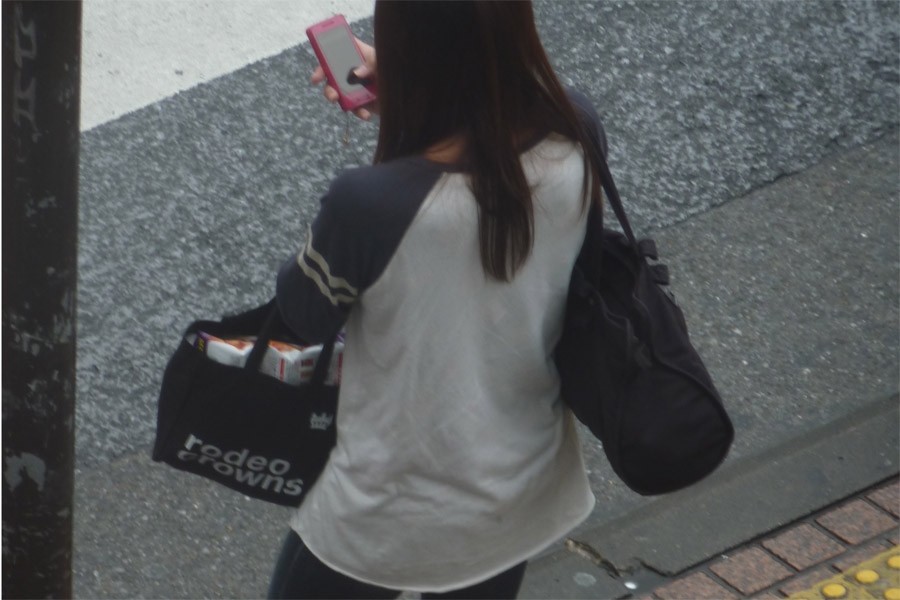Street Roots, New Avenues for Youth and Donor Bridge weigh the power of tech to improve the lives of people on the street. Service providers also grapple with the negative impacts of mobile tech on their clients.
The newspaper and resource guide content produced by the nonprofit organization Street Roots is timely and relevant. The payment and delivery systems — not so much.
 Director Kaia Sand says she is considering Venmo, a digital wallet, as a mobile payment option for the Streets Roots newspaper, which is sold on the street by homeless and low income individuals. As it stands, vendors take cash only, and that’s a problem in a world where fewer and fewer people carry cash.
Director Kaia Sand says she is considering Venmo, a digital wallet, as a mobile payment option for the Streets Roots newspaper, which is sold on the street by homeless and low income individuals. As it stands, vendors take cash only, and that’s a problem in a world where fewer and fewer people carry cash.
Sand says she has been in discussion with Real Change, Street Roots’ sister organization in Seattle, which uses Venmo.
In the meantime, the nonprofit is working with a group of Portland State University grad students to digitize the Rose City Resource guide, a print compilation of service providers ranging from shelters to needle providers.
With funding from a climate change resilience grant, the geography and urban planning students are creating an interactive web mapping tool that will also upload data to the Northwest Open Data Exchange, a PSU-managed open data site.
The idea is to give Street Roots an easy way to update the Guide and to help service providers and clients navigate multiple resources (identify what bus lines go to what shelters, for example).
The PSU students are part of a loose professional affiliation called the Mapping Action Collective, aimed at leveraging GIS mapping tools for the social good.
“GIS is highly quantitative; there is not a lot of critical thinking going on,” says one of the students, Timothy Hitchins. “We’re trying to be collaborators, to be schooled by the organizations doing the hard work, so we can fill the social justice space.”
From the director: “Our newspaper is printed, but we also really care about the digital presence,” Sand says. “Doing one doesn’t mean you can’t do the other. We have to keep nimble.”
Brother, can you spare a digital coin?
Giving people living on the street tokens to be reimbursed for food or shelter is not a new idea.
Now a couple of Lewis & Clark graduates are trying to build an app for that. The startup Donor Bridge would allow good samaritans to use their smartphones to buy people in need a range of products and services, from a burrito at Chipotle to a few nights in a hotel. Interactions with people on the street can be fraught, says co-founder Ray Torkelson, 24.
“There’s a certain friction, when you’re the person walking by: What can I do that’s going to be helpful in the short amount of time I have?”
Still in the concept stage, the app expands on some successful crowdfunding Donor Bridge organized that has helped at least one person find housing for several months.
Torkelson, whose day job is interpreting and translating Mandarin, and cofounder Josh Proto are also exploring a digital currency, BridgeCoin, that people could use at participating businesses, who would be reimbursed by Donor Bridge for 90% of the cost. It’s a community investment solution to a problem that can seem insurmountable.
“We want to break down barriers, build a bridge between people,” Torkelson says.
From the co-founder: Torkelson says he comes from a “privileged background” but also struggled as an adolescent in Portland and attended a boarding school out of state. “If I hadn’t had privileges, I could have ended up on the street.”
Smart youths
Twenty years ago, a young person experiencing abuse or homelessness might have walked up to a man on the street saying, “I don’t have a place to sleep tonight.”
That unsafe behavior has migrated off the street and online, says Sean Suib, executive director of New Avenues for Youth.
Today, a young person can go on a dating site like Tinder “and go from one place to sleep to another without having to go to a shelter,” Suib says. “It happens all the time.”
 Like many agencies serving vulnerable populations, New Avenues is grappling with the impacts of technology — good and bad. On the plus side: New Avenues has beta tested a gaming app that allows young people to slowly accumulate job-readiness skills.
Like many agencies serving vulnerable populations, New Avenues is grappling with the impacts of technology — good and bad. On the plus side: New Avenues has beta tested a gaming app that allows young people to slowly accumulate job-readiness skills.
Suib says an app for foster care transition is another active area of interest. The idea is to create a peer network, a Facebook-like platform that would include tools to help kids moving out of temporary families.
New Avenues has participated in a We Code for Good project featuring Puppet and Nike; another hackathon for transitional foster youth will take place at the end of May. “Homeless youth aren’t any different than any other youth,” Suib says. “We all need to figure out how to use social media to communicate or we’re not going to be able to intervene.”
From the director: “Years ago, Stark Street had a high concentration of underage trafficking,” says Suib. “Now you walk up and see Kenny and Zuke’s, Bamboo Sushi. Where did underage sex trafficking go? A lot of it went via technology.”
Sean Suib
A version of this article appears in the May 2018 issue of Oregon Business,






